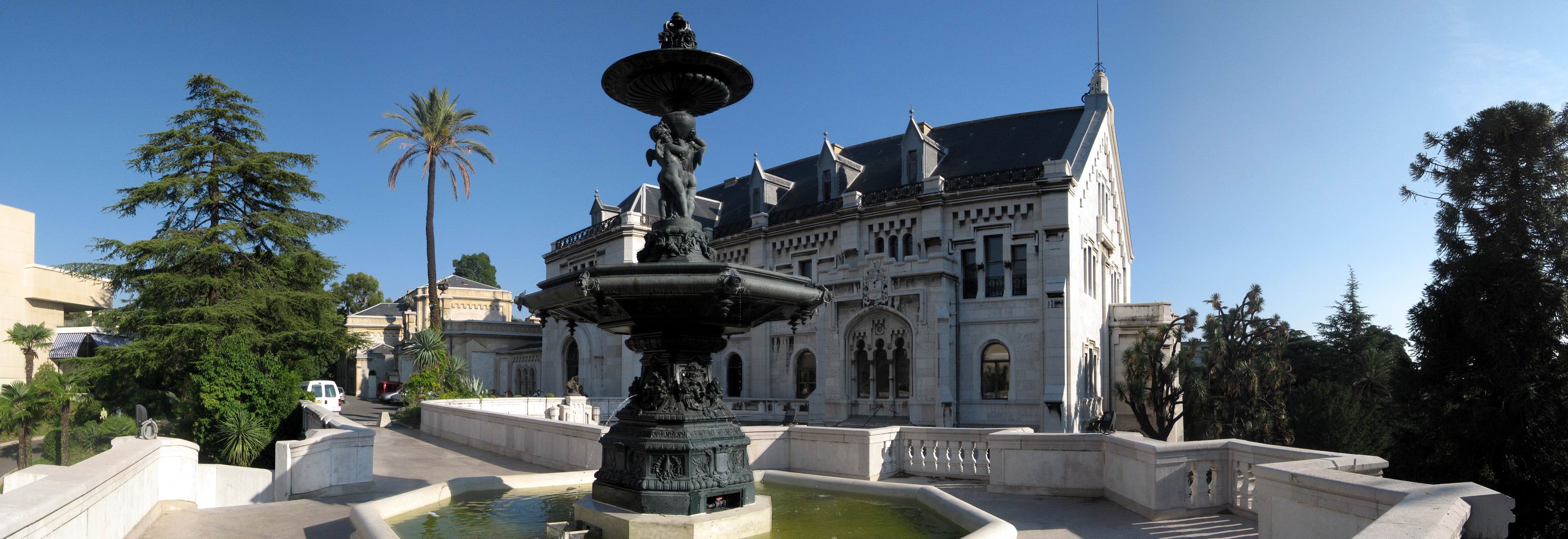June 14th
|
June 15th
|
June 16th
|
8:30 - 9:00 Registration
|
|
|
9:00 - 10:30 V. Koltchinskii (course 1)
|
9:00 - 10:30 R. Willett (course 2) |
9:00 - 10:00 R. Nickl
|
10:30 - 11:00 Coffee break
|
10:30 - 11:00 Coffee break |
10:00 - 10:30 Coffee Break
|
11:00 - 12:00 L. Cavalier
|
11:00 - 12:00 V. Spokoiny
|
10:30 - 11:30 P. Pudlo
|
12:00 - 14:30 Lunch
|
12:00 - 14:30 Lunch |
11:30 - 12:30 G. Lugosi
|
14:30 - 16:00 R. Willett (course 1)
|
14:30 - 16:00 V. Koltchinskii (course 2) |
12:30 - 14:00 Lunch
|
16:00 - 16:30 Coffee Break
|
16:00 - 16:30 Coffee Break |
|
16:30 - 17:30 L. Rosasco
|
16:30 - 17:30 T-M Pham-Ngoc
|
|
17:30 - 18:30 C. Tuleau-Malot
|
17:30 - 18:30 E. Arias-Castro
|
|
__________________________________________________________________________________
Detailed Program
Tuesday, June 14th
9:00 - 10:30 V. Koltchinskii (course 1) Low Rank Matrix Recovery: Regularization and Oracle Inequalities
We will discuss a problem of
estimation of a large matrix A based on independent measurements of n
linear functionals of this matrix. If A is low rank or it can be well
approximated by low rank matrices, the problem is to estimate A with an
error that properly depends on the rank rather than on the overall size
of the matrix. The basic examples of such problems are the matrix
completion that has been intensively studied in the recent years,
especially, in the case of noiseless measurements (e.g., Candes and
Recht (2009); Candes and Tao (2009)), and the problem of estimation of
a density matrix in quantum state tomography (e.g. Gross (2009)). We
will discuss the most popular low rank estimation method based on
nuclear norm penal- ization as well as some other methods suitable in
the case of density matrix estimation (von Neumann entropy penalization
and low rank recovery “without penalization”). Our goal is to
establish low rank oracle inequalities in spirit of recent work on von
Neumann entropy penalization by Koltchinskii (2010) and on nuclear norm
penalization by Koltchinskii, Lounici and Tsybakov (2011). The proofs
of these inequalities rely on a variety of empirical processes tools
including concentration inequalities, generic chaining bounds and
noncommutative extensions of classical exponential bounds for sums of
independent random variables.
11:00 - 12:00
L.
Cavalier
Inverse problems in statistics
There exist many fields where inverse problems appear.
Some examples are: astronomy (blurred images of the Hubble satellite),
econometrics (instrumental variables), financial mathematics (model
calibration of the volatility), medical image processing (X-ray
tomography) and quantum physics (quantum homodyne tomography). These
are problems where we have indirect observations of an object (a
function) that we want to reconstruct, through a linear operator A.
One needs regularization methods in order to get a stable and accurate
reconstruction. We present the framework of statistical inverse
problems where the data are corrupted by some stochastic error. This
white noise model may be discretized in the spectral domain using
Singular Value Decomposition (SVD), when the operator A
is compact. Several examples of inverse problems where the SVD is known
are presented (circular deconvolution, tomography). We explain some
basic issues regarding nonparametric statistics applied to inverse
problems. Standard regularization methods are presented
(projection, Landweber, Tikhonov,...). The notion of optimal rate of
convergence leads to some optimal choice of the tuning parameter.
However these optimal parameters are unachievable since they depend on
the unknown smoothness of the function. This leads to more recent
concepts like adaptive estimation and oracle inequalities. Data-driven
selection procedures of the regularization parameter are discussed.
14:30 - 16:00
R. Willett (course 1)
Signal Reconstruction from Poisson Data – Performance Bounds, Algorithms, and Physical Constraints
Many critical scientific and engineering applications rely upon
the accurate reconstruction of spatially or temporally distributed
phenomena from Poisson data. When the number of observed events is very
small, accurately extracting knowledge from this data requires the
development of both new computational methods and novel theoretical
analysis frameworks. This task is particularly challenging since
sensing is often indirect in nature, such as in compressed sensing or
tomographic projections in medical imaging, resulting in complicated
reconstruction problems. Furthermore, limited system resources, such as
data acquisition time and sensor array size, lead to complex tradeoffs
between sensing and processing. All of these issues combine to make
accurate reconstruction a complicated task, involving a myriad of
system-level and algorithm tradeoffs.
In this talk, I will describe a theoretical framework for assessing
tradeoffs between reconstruction accuracy and system resources when the
underlying intensity is sparse. The theory supporting these methods
facilitates characterization of fundamental performance limits.
Examples include lower bounds on the best achievable error performance
in photon-limited image reconstruction and upper bounds on the data
acquisition time required to achieve a target reconstruction accuracy.
We will also see that compressed sensing with Poisson noise has very
different properties than more conventional formulations. Finally, I
will describe novel reconstruction algorithms which use a penalized
negative Poisson log-likelihood objective function with nonnegativity
constraints (since Poisson intensities are naturally nonnegative). The
effectiveness of the theory and methods will be demonstrated for
several important applications, including coded aperture imaging and
medical image reconstruction.
16:30 - 17:30
L.
Rosasco
Spectral Methods for Computational Learning
In this talk we present a class of spectral methods to
learn from high dimensional data sets arising in a wide variety of
applications. The approach we propose can be applied to supervised
learning (regression, classification, multiclass/multitask) as well as
to unsupervised learning (set/support estimation). Empirically the
derived algorithms obtain state of the art performances both on
simulated and real data, while achieving optimal learning rates from a
theoretical point of view. Interestingly, our analysis indicates a deep
connection between inference and computational principles. The tools we
build upon are spectral and analytical methods that highlight the
relationships between learning theory and other fields in applied
sciences, such as inverse problems, statistics and signal processing.
17:30 - 18:30
C. Tuleau-Malot Adaptive density estimation: a curse of support?
The estimation of a density on the real line is a
classical problem since it is at the core of many data preprocessing.
However, in a lot of works, a main assumption is that the support of
the underlying density is a known compact, and often that the density
is bounded. With P. Reynaud-Bouret and V. Rivoirard, we developped a
new adaptive method, based on wavelet thresholding, which makes as few
assumptions as possible on the density and in particular, no assumption
on its support. In this presentation, after a state of the art, a first
part is devoted to the practical point of view. I compare, in practice,
our method to some others, in particular to gaussian kernel, to the
root-unroot algorithm and to the Willet and Novak one. Therefore, I
show the influence of the support on the estimation. The second part is
more theoretical and exposes the main results obtained.
Wednesday, June 15th
9:00 - 10:30
R. Willett (course 2)
Signal Reconstruction from Poisson Data – Performance Bounds, Algorithms, and Physical Constraints
11:00 - 12:00
V. Spokoiny Parametric inference. Revisited
The classical parametric theory is based on the
assumptions of parametric structure and of a large sample size
(relative to the number of parameters). The talk discusses the
parametric estimation and inference problem in the situation when the
parametric model is possibly misspecified and the sample size is fixed.
The main results describe the concentration properties of the (quasi)
MLE and the coverage bounds of the likelihood based confidence sets.
Corollaries about approximate efficiency and expansions of the MLE are
presented. We also discuss extensions to penalized MLE, Bayes and
semiparametric estimation.
14:30 - 16:00
V. Koltchinskii (course 2)
Low Rank Matrix Recovery: Regularization and Oracle Inequalities
16:30 - 17:30
T-M Pham-Ngoc Spherical deconvolution: the dictionary approach and needlet thresholding algorithm
In this talk, we deal with the problem of spherical
deconvolution. We present two different approaches to this problem, a
thresholding algorithm through the very well localized basis of
needlets and a well calibrated l1 criterion which allows to consider an
overcomplete dictionary based on needlets and spherical harmonics. We
obtain theoretical performances for these two methods and we compare
their practical performances.
17:30 - 18:30
E. Arias-Castro Cluster Detection in Networks using Percolation
We consider the task of detecting a salient cluster in a
(sensor) network, i.e., an undirected graph with a random variable
attached to each node. Motivated by recent research in environmental
statistics and the drive to compete with the reigning scan statistic,
we explore alternatives based on the percolative properties of the
network. The first method is based on the size of the largest
connected component after removing any node in the network whose value
is lower than a given threshold. The second one is the upper level set
scan test introduced by Patil and Taillie (2003). We establish their
performance in an asymptotic decision theoretic framework where the
network size increases. We make abundant use of percolation theory to
derive our theoretical results and our theory is complemented with some
numerical experiments. [Joint work with Geoffrey Grimmett (Cambridge)]
Thursday, June 16th
9:00 - 10:00 R. Nickl
Adaptive Nonparametric Confidence Sets
I shall review some of the key problems with and results on adaptive
nonparametric confidence sets, both for confidence balls and confidence
bands. The various ways adaptive confidence statements are connected
with nonparametric testing problems will be highlighted, and I will
discuss recent results that give necessary and sufficient conditions
for existence of adaptive confidence balls and bands, and explain the
intimate link of such results to the study of certain minimax
nonparametric hypothesis testing problems where both the null and
alternative hypothesis are composite and infinite-dimensional.
10:30 - 11:30
P. Pudlo Approximation Bayesian computational (ABC) methods: an overview
Also known as likelihood-free methods, approximate Bayesian
computational (ABC) methods have appeared in the past ten years as the
most satisfactory approach to untractable likelihood problems, first in
genetics then in a broader spectrum of applications. However, these
methods suffer to some degree from calibration difficulties that make
them rather volatile in their implementation and thus render them
suspicious to the users of more traditional Monte Carlo methods.
We will review its recent developments, and illustrate those methods in
some population genetics experiment, where models based on coalescence
processes do not allow computation of the likelihood.
11:30 - 12:30
G. Lugosi Random geometric graphs in high dimensions.
Motivated by a statistical problem of testing dependencies, we
introduce a model of random geometric graphs in high dimensions. We
show that as the dimension grows, the graph becomes similar to an
Erdôs-Rényi random graph. We pay particular attention to the clique
number of such graphs and show that it is very close to that of the
corresponding Erdôs-Rényi graph when the dimension is larger than log^3
n where n is the number of vertices. The talk is based on joint work
with Luc Devroye, András György, and Frederic Udina.



